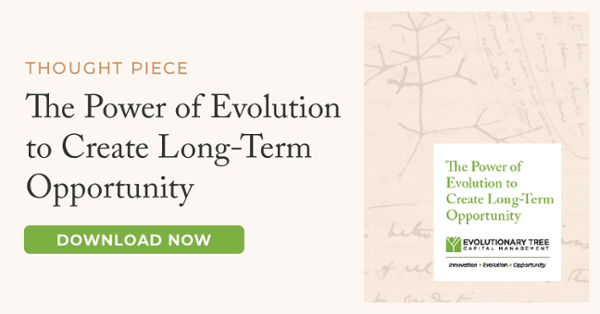In a fast-moving, 21st century economy, innovation permeates our lives. In the past year alone, we’ve found and developed multiple vaccines for a novel virus that threated society. That’s innovation. In response to that virus, we’ve found news ways to conduct school and work from our living rooms. That’s innovation. We’ve also found new ways to shop and entertain ourselves. That’s innovation.
In an ever-changing world, those examples are just the tip of the iceberg. Everyone constantly senses the power of innovation in their lives. The struggle for investors: Finding appropriate ways to invest in the innovative businesses driving the most substantial changes, while avoiding many of the hyped products and services not yet ready for primetime. Navigating these dynamics lies at the heart of what we do at Evolutionary Tree.
To help understand how our investment approach enables investors to benefit from the power of innovation, this blog looks at how we define innovation, how we avoid hype, and why the current economic environment may be more conducive to producing profound innovations.
How We Define Innovation
First, for investors to gain from innovation, how one defines it matters. At Evolutionary Tree, we don’t look for incremental changes. We define innovation through the lens of evolutionary shifts. We define an evolutionary shift as an inflection point when an industry shifts from an old generation (of a product, service, or business model) over to a “next generation” or new offering that provides advantages versus the “old way” of doing things.
Innovations that drive these evolutionary shifts come in many forms and can be found in all industries and sectors across the economy. Examples of innovations that we believe contribute to sustainable growth include technological innovation, product innovation, service or experience innovation, process or cost innovation, and/or business model innovation.
In addition to contributing to sustaining growth for leading innovative businesses, new innovations may also enable innovators to take market share, create competitive advantage, and enhance profitability over time. Taken together, we believe that innovation is a fundamental root cause and driver of sustainable growth and value creation over time.
Avoiding Hype
There are many thousands of innovations in the world, yet most are incremental or easily copied by competitors. Additionally, technologies don’t come into the world fully developed and ready for primetime. Instead, technologies start with early proof of concept that merely shows the long-term potential of the technology. Only after numerous iterations and many, many years of development does a technology mature into a version ready for the masses.
To help us avoid early-stage and hyped technologies—those not yet ready for primetime adoption—we evaluate whether a new innovation has surpassed two critical hurdles: 1) technical feasibility and 2) business model feasibility. For a technology to pass technical feasibility it must be effective and reliable. And, just because a new innovation shows technical feasibility, doesn’t mean it is ready for consumers. The product or service must demonstrate its ability to survive in the wild, in the marketplace, and for specific use cases and by actual users.
To assess whether a product or service has business model feasibility, we ask: Can the technology attract recurring user adoption, driving sustainable revenue and eventually, profit growth? Technologies that don’t pass these two hurdles are, in our opinion, still in the hype phase and not ready for mainstream adoption. We actively avoid these types of innovation, only focusing on ones that pass both our technical and business model hurdles, which we believe helps lower risk when investing in innovation.
Lastly, an important part of our research process is evaluating each firm's ability to build an innovation moat around its innovations through the development of competitive advantages, such as patents, strong brands, scale, network effects, lock in, and/or switching costs.
The Age of Innovation
Importantly, at Evolutionary Tree, we believe society is at a point in which the pace of meaningful innovation is quickening. Looking at investing from an innovation-focused vantage-point, we strongly believe the current economic environment is highly conducive to a steady stream of important and profound innovations across the economy, particularly with industry after industry becoming tech-enabled through digital transformation.
We describe the current era we live in as the Age of Innovation. It is our mission to own a high-quality collection of leading and emerging innovators that may benefit from these dynamics. Our increasingly intellectual capital-based economy is generating a growing number of innovative businesses in a variety of industries, most notably in technology, life sciences, fintech, and digital consumer spaces.
We believe the development of innovation and its resultant pattern of evolutionary change is the primary engine of growth for companies, industries, and the economy—and, in turn, is the underlying driver of long-term wealth creation.


